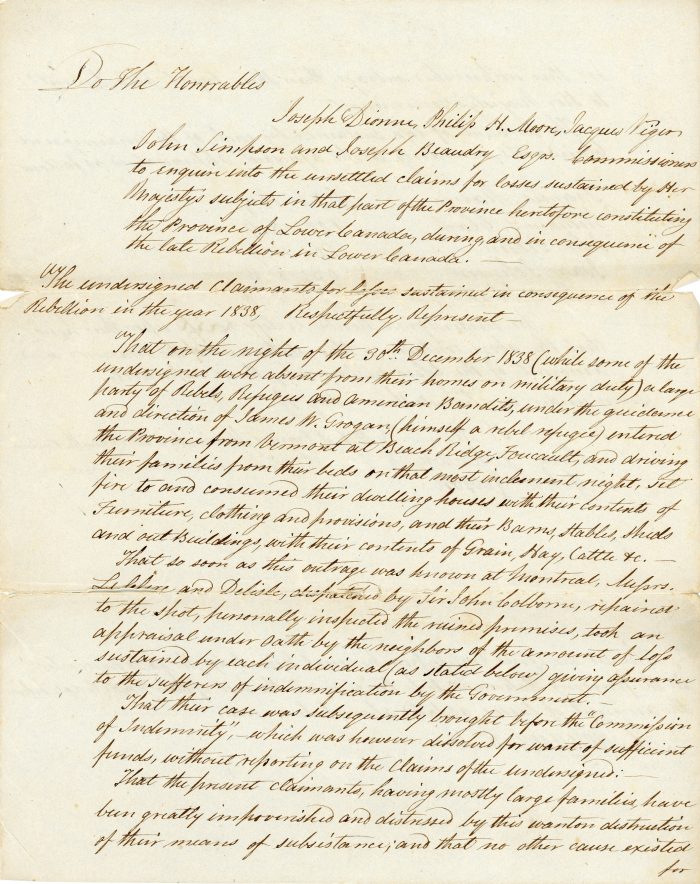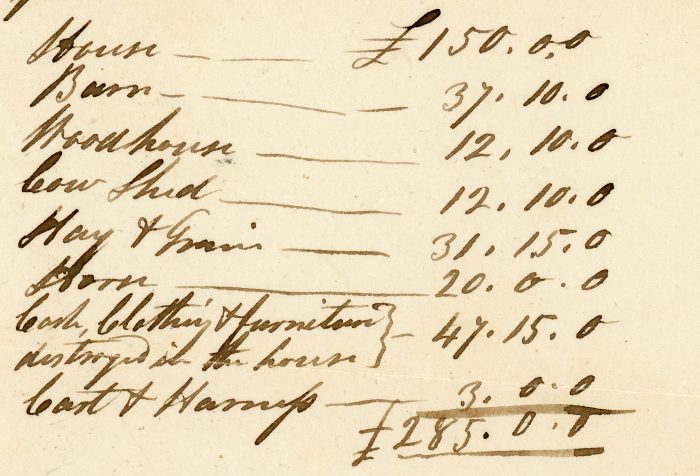

Share
The Rebels Come to the Townships
May 17th, 2019
“On the morning of the 3rd day of February 1839 while yet dark, their dwelling house was surrounded and violently entered by a large number of armed Rebels from the United States who, after first binding and subsequently most barbarously and dangerously wounding [Abraham Vosburgh and Peter Vosburgh], memorialists, with sabers and bayonets, pillaged and set fire to the house and burned their barns and sheds with their contents together with a valuable stock of horses and farm cattle.”
In reading rebellion loss claims such as this one, which took place in Caldwell’s Manor on the western side of Missisquoi Bay, it would be easy to imagine a countryside overrun with looting and vandalism. However, in reality, the people of the Eastern Townships found themselves divided in opinion but, ultimately, kept themselves out of the most heated parts of the Rebellions of 1837-1838.
As the political tensions in Lower Canada escalated through the 1830s, culminating in the Rebellions of 1837-1838, it is not representative to generalize which side “most” of the early settlers of the Townships supported. There were vocal and active local groups, accompanied by newspapers largely dedicated to influencing political opinion, that expressed support for either side of the dispute. While the complexity of the Rebellions is too much for a short article, it can be boiled down to (in very general terms), a dispute between the British-dominated Legislative Assembly and the Patriotes: a group of largely French-Canadians, led by Louis-Joseph Papineau, whose initial main desire was to implement a more balanced government structure (taking power away from the British minority), which would in turn also allow for a more even distribution of government funds.
For those in the Eastern Townships, the early stance of the Patriotes was appealing to many. In general, the 1820s and 1830s had been economically difficult times in the Townships and, with their small population and geographic distance from Montreal and Quebec City, there were groups of settlers that could get behind political changes that held the possibility of more funds directed to the region and better representation in government. However, as the political stance of the Patriotes became more radical, they lost much of the earlier enthusiastic support from English-speaking groups. As a result, armed conflict was avoided in the Townships, unlike in other areas of the province.
Yet as the Patriote militants fled the province following the ultimately unsuccessful rebellions in Upper and Lower Canada, those living along Quebec’s southern border continued to endure ongoing threats to their property from the rebel groups. Once in the United States, the Patriotes found local support among some Americans who fancied helping the Patriotes overthrow the yoke of British oppression.
The extent of their action, however, was only to destroy the property of those deemed to be supporters of “Her Majesty’s government,” in quick cross-border raids, leaving those nearest the frontier most susceptible. The complete destruction of Abraham and Peter Vosburgh’s property, described earlier, was the result of one of these raids. Other surviving accounts such as that of Francis Manie and Isaac Johnson in Foucault recount similar experiences to those of the Vosburghs.
With the passing of the Rebellion Losses Bill in 1849, those who had suffered great losses were able to receive some compensation for damages caused by the Rebellions. It is unknown, however, if the gentlemen named above ever received any compensation.

